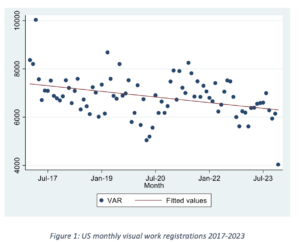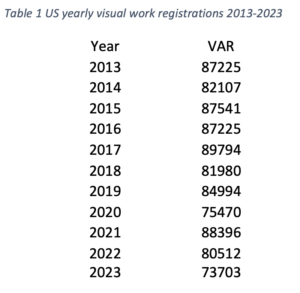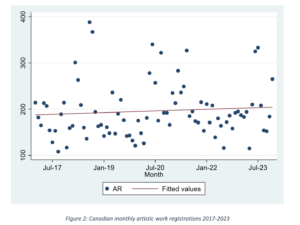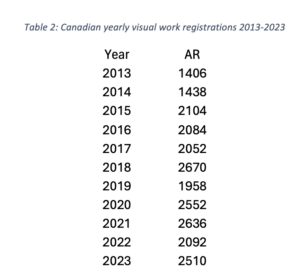
In the middle of 2022, three significant AI text-to-image generators were made available to the public: Dall-E 2 (April 2022), Midjourney (July 2022), and Stability Diffusion (August 2022). In addition to raising questions about ownership of outputs, infringement in training, and the future of copyright as a policy tool to encourage creativity, economists are in the early stages of analysing the effects of these technologies on human creativity. These questions are interrelated as one argument in favour of copyright restrictions on training is the protection such restrictions will provide to human creators against ruinous AI competition. Against that background, this blog post provides some tentative musings on the impact of text-to-image generators on human artistic creativity by analysing recent US and Canadian copyright registrations for artistic works.
To better understand the effects of text-to-image generators on artistic creativity, I compare registrations pre- and post-August 2022. Both the US Copyright Office and Canada Intellectual Property Office (CIPO) maintain publicly searchable copyright registers. While not a precondition of ownership, both jurisdictions encourage registration in various ways: in the US, registration is required for domestic copyright owners to initiate copyright infringement actions; in Canada, registration is evidence of ownership in infringement cases. Of course, most artistic works are still not registered and accordingly registration data provides only very limited information about creativity overall. Nevertheless, the data might provide some interesting information, albeit with important caveats, about a subset of artistic creativity, namely, artistic creativity that is commercially significant enough to warrant the small time and expense of copyright registration. For simplicity, I will label this ‘commercial significant artistic creativity’. The August 2022 date is reflective of the change in technology between April and August 2022.
In analysing the data, one might hypothesise that US registrations have decreased post August 2022 while Canadian copyright office registrations have increased. The reason for such a hypothesis lies in the different policies adopted towards registering generative AI works. It has been relatively long-standing policy of the US Copyright Office to register only human authored works. In 2018, the Copyright Office refused to register a computer-generated work (An Entry into Paradise) produced by Stephen Thaler’s Creativity Machine, and in October 28, 2002, the Office cancelled the first registration related to a work produced through text-to-image generator: Zarya of the Dawn, generated by Kris Kashtanova. With such policies in place, one might expect a drop in registrations as some human artists at the margin switch to generating artistic works using the new technologies and no longer are eligible for copyright (as in the Zarya of the Dawn example). In contrast, the CIPO has arguably adopted a more liberal attitude to computer-generated works. In 2021, Ankit Sahni registered an artistic work titled SURYAST and listed ‘RAGHAV Artificial Intelligence Painting App’ as a co-author, while some ‘100% AI-Generated’ works have also been registered. With this policy in place, one might expect an increase in copyright registrations as AI tools expand artists’ production capacity and such ‘AI-assisted’ works are eligible for registration.
The data provides some evidence for the hypothesis. Starting with the US, if one plots the monthly copyright registrations for visual works (that is, those beginning with a registration number VA) from January 2017 to December 2023, one finds registrations are decreasing over the period (see Figure 1). Using the same data and a dummy variable (0 for registrations pre-August 2022, 1 for registrations post-August 2022), we can perform a univariate regression analysis. The result is the cut-off date of August 2022 is associated with a drop in approximately 765.6971 monthly registrations for visual works. While there are caveats about the statistical quality of such a regression analysis, it is worth noting that such a finding is statistically significant (P value of 0.001 at the 5% level). Of course, we do also see a drop in registrations in early 2020, but given we see something similar in the CIPO registrations, this is quite plausibly the impact of the Covid-19 pandemic. If we change the cut-off point to a random date – in this case August 2019 – we also find a decrease in monthly registrations, but at a lower rate of 576.2075. This data is also consistent with a yearly drop in registrations for visual works presented in Table 1.


Turning to Canada, the data is mixed and inconclusive. Figure 2 plots the monthly registrations for works in the ‘artistic’ category in the CIPO database. The univariate regression analysis demonstrates the cut-off date is associated with a monthly increase of 6 registrations, but this is not statistically significant (P value of 0.715). Once again there is a bit of a dip in registrations in early 2020 with March recording the third lowest number of registrations for the entire period. Table 2 demonstrates the yearly registrations from 2013 to 2023 showing that 2023 was the year with the fourth largest volume of artistic work registrations.


Before concluding, it is worth noting why I have not included the data from early 2024 in this exercise. The reason is that in the first three months of 2024, US registrations for visual works have fallen off a cliff with 1648 in January, 221 in February, and only 8 in March. Meanwhile, in Canada, the numbers are as one would expect (177, 244, 162 respectively). Given the huge drop, I expect (indeed hope!) that the US data reflects some sort of reporting lag. Furthermore, if there is a significant lag in reporting, then registrations at the end of 2023 may also be inaccurate.
Overall, what does this exercise tell us about the state of commercially significant creativity following the introduction of AI text-to-image generators? Admittedly, not very much. The Canadian data tells us almost nothing of statistical significance. The US data might signify a decrease in human authored commercially significant creative output. If true, that finding raises normative questions about what type of creativity we value as a society and how that creative output may be best supported in the future. That conclusion must, however, be caveated heavily by acknowledging the potential for reporting errors and the difficulty in untangling other causes of the drop in registrations. Perhaps, therefore, the most significant conclusion is that we are still profoundly in the dark about how these new technologies will affect human creativity in the future. With that in mind it may be prudent to approach claims about the need to protect human creators from ruinous AI competition with a degree of caution.
_____________________________
To make sure you do not miss out on regular updates from the Kluwer Copyright Blog, please subscribe here.
Kluwer IP Law
The 2022 Future Ready Lawyer survey showed that 79% of lawyers think that the importance of legal technology will increase for next year. With Kluwer IP Law you can navigate the increasingly global practice of IP law with specialized, local and cross-border information and tools from every preferred location. Are you, as an IP professional, ready for the future?
Learn how Kluwer IP Law can support you.


